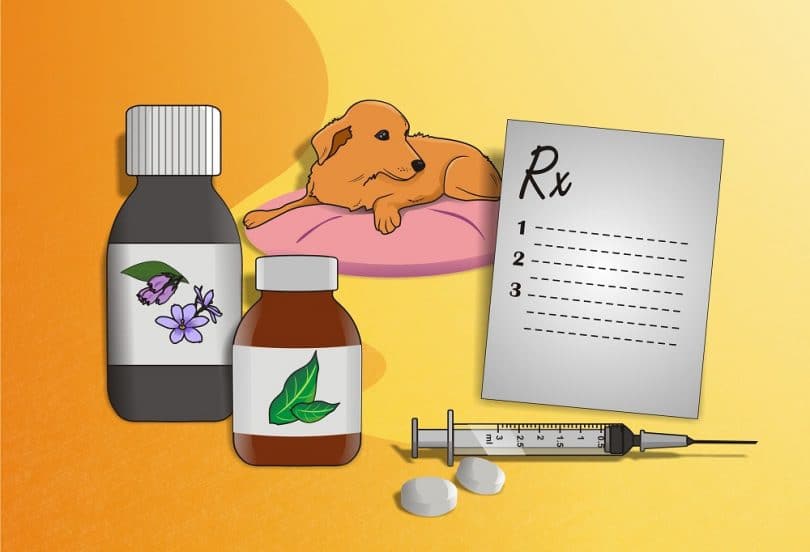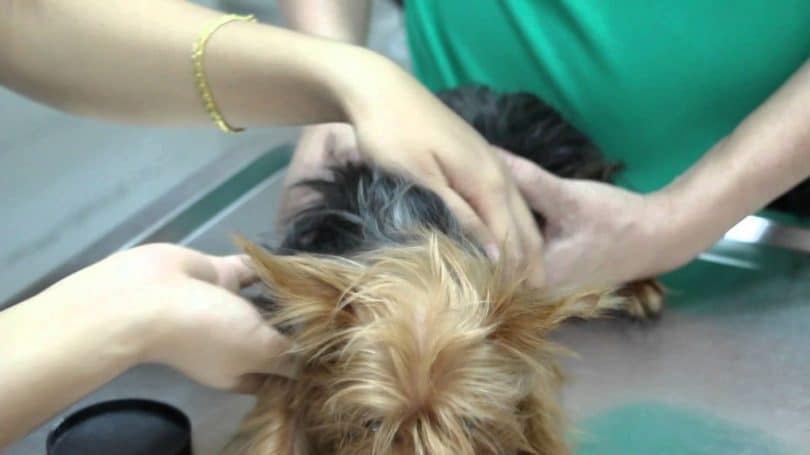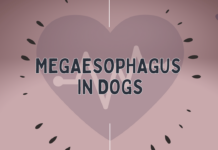You have a female dog in the house and she is not yet spayed. Suddenly she starts acting lethargic and nauseous. She has gained weight, is exhibiting mammary enlargement and even started producing milk.
By the looks of it, she really does seem pregnant. But then she has never been out of your sight and you know she hasn’t been in contact with a male dog. What is happening?! Relax and breathe.
Most commonly known as false pregnancy in dogs, this condition is actually not that uncommon in intact or unsprayed female dogs. Understanding this condition fully leads to better resolution of the whole situation.
How to Know if a Dog Is Experiencing False Pregnancy?
When a female dog is having phantom pregnancy, the symptoms she displays are more or less similar to what an actually pregnant dog would show.

Chances are high that it is pseudopregnancy if you are sure that your pet has not been in close contact with intact male dogs but she exhibits a lot of the following signs:
Physical changes
- Weight fluctuations (there might be weight loss due to lack of appetite or weight gain due to sudden increase in appetite)
- Abdominal distention, enlargement or swelling
- Mammary glands enlargement
- Mammary glands secretion (can look like water or brownish fluid)
- Milk production
- Vomiting
- General lack of energy, lethargy
- Mucoid vaginal discharge
- Appearing as if she is going into labor
Behavioral changes
- Aggression (the dog will be grumpy towards you or other dogs in the house)
- Depression (suddenly becomes withdrawn or clingy)
- Restlessness (there might be lots of whining involved too)
- Anxiety
- Nesting behavior (watch out for your dog tearing up paper or a blanket and making a nest somewhere in the house which she thinks is safe and comfortable)
- Digging (often combined with the nesting behavior)
- Mothering (she might latch onto a stuffed toy, shoe or other items and literally mother these objects)
- Self-nursing activity
As can be seen on this list, pseudocyesis can be tough to distinguish from real pregnancy in dogs and it can be quite stressful dealing with the whole matter.
After all, although you are fully committed to your pet right now, you might just not be ready to have a whole litter on your hands.

This is why all dog owners are highly advised to be vigilant when their intact dogs are in heat. Determining a phantom pregnancy can be done more decisively if you are sure that your pet has not bred.
What Causes Pseudopregnancy in Dogs?
Pseudocyesis is basically a condition triggered by hormonal fluctuations in female dogs.
What happens is that when they undergo estrus, otherwise known as being in heat, their progesterone levels increase considerably and this could go on for as long as the heat cycle lasts.
Now once that is over, progesterone levels decrease but another hormone, prolactin, is produced more in the dogs’ bodies. When this happens, a hormonal imbalance can occur.
This disparity can result to physiological changes in the dogs’ bodies, which can make them think they are pregnant and would then result to them exhibiting behaviors common to expectant dogs.

This is not that rare a condition and often happens about 4 to 6 weeks after a female dog’s heat cycle.
The pregnancy symptoms can go for several months and can be so convincing that even expert breeders can be fooled. So if your dog shows signs of pregnancy but you are convinced she has not bred, it is best to check with your veterinarian just to confirm things.
If the situation is indeed false pregnancy, the symptoms can be waited out as they often disappear on their own. However, if this persists, then it is best to talk to your vet and come up with the most appropriate solution for your dog.
Other causes
There are times when regular hormonal imbalance is not the cause of the dog false pregnancy. It could be any or a combination of the following:
Hypothyroidism – a dysfunction in a dog’s thyroids can lead to blood changes which may then result to the overproduction of prolactin. As outlined above, a hormonal imbalance may occur and lead to false pregnancy.
It is worth knowing that there are several dog breeds predisposed to hypothyroidism. These include Mastiffs, Rottweilers, Dalmatians, Siberian Huskies, American Staffordshire Terriers, Malteses, Border Collies, Chinese Shar-Peis, Weimaraners and Bernese Mountain Dogs. If you own any of these breeds, canine hypothyroidism may be something you want to know more about and prepare for.
Mastitis – also known as inflammation of the mammary glands, this is a condition wherein a female dog’s milk ducts get infected.
Symptoms can include swelling. Although this often happens to dogs that are actually pregnant and are lactating, the reverse can be true – meaning when there is an infection, the swelling of the mammary glands might lead your dog to think she’s pregnant and she might even lactate.

Cancer of the mammary gland – any tumor growing in the mammary gland can lead to inflammation and swelling similar to mastitis.
Same as above, your pet may think she is pregnant, which can result to her exhibiting other symptoms.
Abdominal enlargement – there are various reasons why this could happen, among which are: organ swelling, uterus infection or fluid accumulation.
At first it might seem that indeed your dog is pregnant because her stomach is enlarging. She might think this is so as well, and once again might display pregnancy signs.
With these causes, it really is best to see a veterinarian if your dog starts showing phantom pregnancy signs.
Although a simple hormonal imbalance can go away on its own, the other underlying causes above can be very serious and would require immediate attention.
Another important thing to remember is that pseudopregnancy can occur after a female dog has been spayed.
If the spaying was done within the heat cycle when progesterone levels were high, the sudden physical change can lead to the hormonal imbalance behind false pregnancies in dog.
So it might be best to confirm with your vet if your dog is in heat or not and if she is, then go through with the spaying after the reproductive cycle. Verifying a dog’s ovulation is easily done through testing progesterone levels.
What Are the Diagnostic Procedures Needed?
The first step is to set an appointment with a trusted vet to have your dog checked. Prepare the details of your pet’s health history. Compile as much information as you can because every little bit of detail is helpful to the vet.
Your dog’s recent behavioral and physical conduct will then be checked as thoroughly as possible. Expect that she will undergo several lab tests including a complete blood count test. Her biochemistry profile will also be checked and a urinalysis is most likely going to be scheduled.
If it is false pregnancy, the tests will often come back showing regular results unless there are other underlying causes such as those outlined above.

To further confirm that it is indeed pseudopregnancy, your vet might request abdominal x-ray imaging and an ultrasound to be done just to make sure there are not any puppies developing.
Radiographs may also be scheduled in order to rule out any chances of your dog suffering from Pyometra, a serious condition that requires immediate action. This disease is basically a build-up of pus inside the dog’s uterus accompanied by severe infection.
Although this illness is not common, if early treatment is not given then the condition can be life-threatening.
Once your vet conclusively rules out any other illnesses and identifies that the condition is indeed false pregnancy, effective treatment can then be carried out.
What Treatments Are Required?
Experts advise that if the symptoms are mild, then owners should just wait things out as the condition will resolve itself in two to three weeks. It is not advisable use warm compresses to mitigate milk production or breast secretions.
It is not a good idea to wrap your dog as well even if you are just trying to minimize the messy effects of lactation. All that these will do is stimulate the mammary glands, which could lead to further inflammation, increased secretion and other complications.
Your dog might become grumpier too because of the discomfort. If your dog licks her breasts constantly, over stimulation could also happen and so it is advised to use an Elizabethan collar on her.
Aside from this, your veterinarian might suggest the use of diuretics (example: Furosemide) and mild sedatives to speed up the recovery process.
To minimize lactation, it can help to decrease your dog’s water and food intake. This can be done by not feeding your dog for 6-10 hours for several nights. This might sound cruel but the lack of food and water will indeed help suppress the lactation process.
Of course, this can be dangerous for your pet if not done right so it is best to seek guidance from the veterinarian when implementing this.

When nesting and mothering behaviors are severe, vets advise to remove the puppy-substitute objects from your dog’s presence. This might lead to more discomfort for your pet but this will hasten the end of the false pregnancy.
Drug therapy may also be suggested by the vet. This involves the use of Bromocriptine (such as Parlodel® and Sandox®), which is a drug used to decrease milk production.
This can be bought from a compounding pharmacy at a relatively reasonable price. The medicine is usually given to your dog for one to two weeks or until the lactation process stops.
A common side effect of this drug is an upset stomach so this is something you need to be prepared for. It must be noted however that this drug has faced many issues in the US despite its wide use in other countries because it can cause abortion in pregnant animals. That is why it must be used with care.
Then there is Cabergoline, another drug that can help speed up the cessation of false pregnancies in dogs. It has fewer side effects but tends to be more expensive than Bromocriptine.
Testosterone and Mibolerone drugs may also be used but each have their own negative side effects and so their use should be carefully assessed by the veterinarian.
Natural supplements may be used as well to help your dog deal with her condition, which can be highly stressful especially if the symptoms are quite severe.
Finally, it is advisable to have your pet spayed about a month after she experienced false pregnancy.
It is not a good idea to have her spayed while she is still in the grips of the condition because this will just cause further stress and does little to relieve the whole situation.
Preventing and dealing with pseudopregnancy in dogs
Spaying as early as possible is the best way to prevent false pregnancy in dogs. Minding your pet’s overall health will go a long way as well.
She should not be subjected to unhealthy diets and living conditions which might lead to problems with the mammary glands and uterus.

When pseudocyesis does occur, it is best to stay calm, patient and understanding.
Pregnancy, real or otherwise, is a stressful condition for any creature and if the humans in the house are anxious, your dog’s stress levels will just increase. So stay grounded and proceed with care and proper guidance from your veterinarian.
If there are children in the house, do your best to keep them aware and instruct them on what to do so as not to aggravate the whole situation.
In Conclusion
Phantom pregnancy is one of the things owners of female dogs will potentially come across. Often it is not a life-threatening situation and can be weathered out.
There might be underlying causes however which need more attention. So as a whole, a veterinarian’s advice is still valuable and best sought when the situation demands it.




